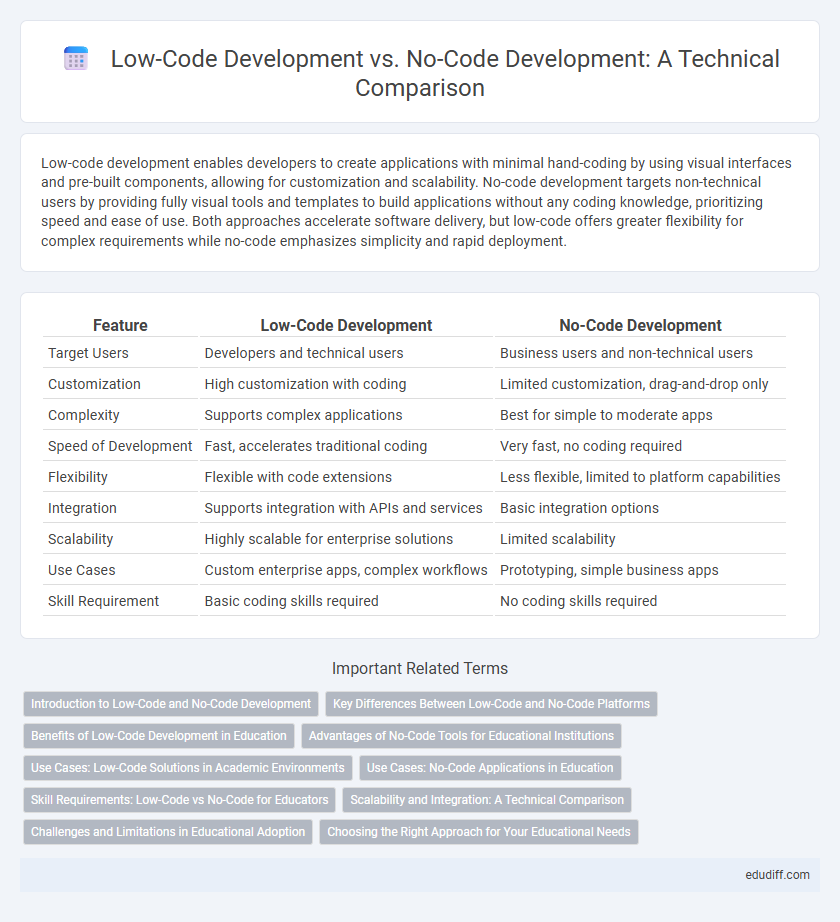Low-code development enables developers to create applications with minimal hand-coding by using visual interfaces and pre-built components, allowing for customization and scalability. No-code development targets non-technical users by providing fully visual tools and templates to build applications without any coding knowledge, prioritizing speed and ease of use. Both approaches accelerate software delivery, but low-code offers greater flexibility for complex requirements while no-code emphasizes simplicity and rapid deployment.
Table of Comparison
| Feature | Low-Code Development | No-Code Development |
|---|---|---|
| Target Users | Developers and technical users | Business users and non-technical users |
| Customization | High customization with coding | Limited customization, drag-and-drop only |
| Complexity | Supports complex applications | Best for simple to moderate apps |
| Speed of Development | Fast, accelerates traditional coding | Very fast, no coding required |
| Flexibility | Flexible with code extensions | Less flexible, limited to platform capabilities |
| Integration | Supports integration with APIs and services | Basic integration options |
| Scalability | Highly scalable for enterprise solutions | Limited scalability |
| Use Cases | Custom enterprise apps, complex workflows | Prototyping, simple business apps |
| Skill Requirement | Basic coding skills required | No coding skills required |
Introduction to Low-Code and No-Code Development
Low-code development platforms enable users to build applications through graphical interfaces and pre-built modules, significantly reducing the need for manual coding and accelerating software delivery. No-code development platforms allow non-technical users to create fully functional applications using drag-and-drop components without any coding knowledge. Both approaches streamline digital transformation by empowering business users and developers to rapidly prototype and deploy applications while minimizing dependency on traditional programming resources.
Key Differences Between Low-Code and No-Code Platforms
Low-code development platforms offer extensive customization through visual modeling tools combined with the option to write code, making them suitable for professional developers and complex applications. No-code platforms provide pre-built templates and drag-and-drop interfaces designed for non-technical users to create simple applications quickly without writing any code. Key differences include the target user base, with low-code catering to developers for more control, while no-code empowers business users focusing on speed and ease of use.
Benefits of Low-Code Development in Education
Low-code development accelerates the creation of customized educational applications by enabling educators and administrators to design tools with minimal coding expertise, enhancing adaptability to evolving learning needs. It supports integration with existing educational systems and databases, ensuring seamless data management and real-time analytics for improved decision-making. This approach reduces dependence on specialized IT staff, lowering development costs and empowering non-technical users to actively participate in digital transformation within educational institutions.
Advantages of No-Code Tools for Educational Institutions
No-code tools empower educational institutions to rapidly create and deploy customized learning applications without requiring extensive programming knowledge, significantly reducing development time and costs. These platforms enable educators to tailor digital experiences to diverse learning needs, promoting inclusivity and enhanced engagement through intuitive drag-and-drop interfaces. By simplifying application management and fostering collaboration between technical and non-technical staff, no-code solutions streamline administrative tasks and support innovation in academic environments.
Use Cases: Low-Code Solutions in Academic Environments
Low-code development platforms enable academic institutions to create customized learning management systems, automate administrative workflows, and integrate various educational tools with minimal coding expertise. These solutions support scalability and flexibility, allowing faculty and staff to adapt applications to evolving curricular and operational needs. Low-code tools accelerate innovation in academic settings by reducing development time and enabling non-technical users to contribute to application design and deployment.
Use Cases: No-Code Applications in Education
No-code development enables educators to create interactive learning modules, student assessment tools, and administrative dashboards without extensive programming knowledge. Platforms like Airtable and Glide allow rapid deployment of customized apps for classroom management and personalized learning experiences. This approach streamlines workflow automation, enhancing teacher productivity and student engagement through accessible technology solutions.
Skill Requirements: Low-Code vs No-Code for Educators
Low-code development requires educators to have a foundational understanding of programming concepts and logic to customize applications effectively, while no-code platforms allow users with minimal technical skills to build applications using intuitive drag-and-drop interfaces. Educators leveraging low-code benefit from enhanced flexibility and control, enabling integration of complex school systems and tailored functionality. No-code tools accelerate deployment and foster rapid prototyping, making them ideal for educators prioritizing ease of use and fast implementation without extensive coding knowledge.
Scalability and Integration: A Technical Comparison
Low-code development platforms offer greater scalability due to customizable code access, enabling complex application architecture and seamless integration with existing enterprise systems via APIs and middleware. In contrast, no-code platforms prioritize ease of use but often face limitations in handling large-scale deployments and integrating with diverse or proprietary systems, restricting flexibility for advanced technical requirements. Scalability in low-code environments supports iterative enhancements and robust data management, making it suitable for enterprise-grade applications demanding extensive backend integration.
Challenges and Limitations in Educational Adoption
Low-code development platforms often face challenges in educational adoption due to the need for basic programming knowledge, limiting accessibility for non-technical students. No-code development tools offer greater ease of use but struggle with scalability and customization, restricting their application in advanced educational projects. Both approaches require significant instructor training and curriculum adjustments to effectively integrate into diverse learning environments.
Choosing the Right Approach for Your Educational Needs
Low-code development platforms provide the flexibility to customize educational applications with minimal coding, making them ideal for institutions needing tailored solutions and integration capabilities. No-code platforms enable rapid deployment of user-friendly educational tools without programming knowledge, suited for educators seeking quick and straightforward implementations. Evaluating technical expertise, scalability requirements, and desired control over features is essential to selecting the most effective development approach for educational objectives.
Low-Code Development vs No-Code Development Infographic

 edudiff.com
edudiff.com